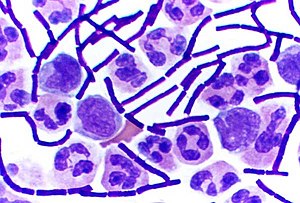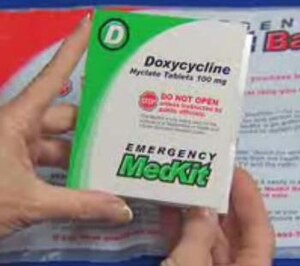Are you dying for a glass of water? You may be if you don’t think ahead and prepare. The following is third in a series by Peter Farmer, who holds advanced degrees in research biology and history, and is also an RN and EMT.
* * *
In a survival situation, finding safe drinking water is of paramount importance. Humans can survive prolonged periods of malnutrition and even starvation, but expire within days without water. As addressed in the previous installment of this series, dehydration progresses rapidly from mild discomfort to debilitation and ultimately, death, if left unaddressed.
What steps can you take to be prepared for scenarios in which you or your loved ones are without a sufficient and/or safe water supply? To answer these questions, we can draw from the knowledge and experience of such diverse sources as scientists/engineers, search and rescue/disaster relief personnel, the military, outdoorsmen, and healthcare providers operating in remote environments. Before getting to their expertise, however, we should better-define the parameters of possible scenarios and the problems they pose. For example….
- What do we mean by “potable” water, i.e., water suitable for drinking? Conversely, what are the most-commonly encountered pathogens and contaminants found in water in the natural environment?
- Can safe, clean water be found in the environment or in wild, and if so how? What are the risks associated with consuming water of questionable or unknown origin?
- Can contaminated water ever be consumed, as an emergency expedient? What are the costs/benefits of such action?
- What illnesses accompany consumption of contaminated water? What are their causative agents and where is one most at-risk for catching water-borne illness? Which water-borne illnesses and pathologies are the most dangerous to humans in terms of morbidity (illness) and mortality (death)?
- What knowledge, skills and kit (equipment) should we acquire to make the above challenges less daunting, or to prevent them altogether?
Define a specific scenario or situation for which you wish to develop a plan. Formulating a water-preparedness plan for yourself in your home and community after a natural disaster is a very different problem from planning for survival water contingencies in a remote region or wilderness area.
The above concerns will be addressed below, and in subsequent installments of this series.
* * *
POTABLE WATER
Drinkable (potable) water is of sufficiently high quality that it can be consumed or used with low risk of immediate or long term harm. In the developed world, most water supplied to residences, businesses, and industry is of this quality, though not all of it is used for human consumption. Conversely, in large portions of the developing world, including significant portions of South America, Africa and Asia, there is insufficient drinking water.1 Therefore, lesson one is that if you plan to travel internationally, do not assume that safe drinking water will be available – especially if you plan to venture off the beaten path or away from civilization.
Contaminants or foreign matter in water, which render it unsafe for human use fall into the following broadly defined categories: pathogenic microorganisms, disinfectants and their by-products, organic and inorganic chemicals, and radionuclides.

Image via Wikipedia
Microorganisms are broadly defined as bacterial, viral, or protozoan. Not all bacteria, viruses and protozoa are disease-causing (pathogenic). Public health authorities are concerned primarily with pathogenic or potentially-pathogenic variants.
Coliform bacteria, such as Enterobacter, Klebsiella, and Escherichia, are commonly-used as diagnostic indicators of water and food quality; they appear rod-shaped under magnification, do not form spores, and Gram stain negative (-). Fecal coliform bacteria are those subtypes found in fecal matter and thus in sewage; Escherichia coli (E. coli) is the prototypical fecal coliform. When the sewers overflow after a flood and run-off contaminates fresh water sources, your local public works should warn you to boil water before using it. The reason? Fecal coliform bacteria. Another commonly-assayed coliform bacteria is Legionella, the causative agent of Legionnaire’s disease, a form of pneumonia.
Enteric viruses, also monitored by water-quality experts, are typically found in the gastrointestinal tract of infected mammals, including humans. There are over 100 polio and non-poliovirus types which cause everything from viral meningitis to endocarditis to gastroenteritis.

Image via Wikipedia
Protozoa are small multicellular (eukaryotic) organisms ranging in size from 10 microns to 1mm, which inhabit a wide variety of aquatic and soil environments. Most are motile (can move) and are easily observed by conventional light microscopy. Many protozoans are parasitic, and cause disease in humans; these disorders may include malaria, amoebiasis, toxoplasmosis, giardiasis, cryptosporidiosis, dysentery and sleeping sickness, among others. In the United States, authorities are especially concerned with contamination of water by Cryptosporidium and Giardia lambia, both of which are commonly found in water contaminated with raw sewage and/or fecal material. Both parasites cause gastrointestinal illness with nausea, cramps, diarrhea and headache among the signs and symptoms.
Drinking water is assayed for suspended solids and turbidity (cloudiness), which are indicators of how effectively water has been filtered or cleansed by treatment. The amount of chlorine, bromine, and associated halogenated compound derivatives – which are used in sewage treatment but can also be disease-causing in excess – are monitored, as are heavy metals such as arsenic, antimony, cadmium, chromium, lead, mercury, and many others. A lengthy list of inorganic and organic compounds, as well as radioactive agents, rounds out the list. The U.S. Environmental Protection Agency (EPA) has set forth detailed standards of allowable contaminants in potable water, which can be viewed at the following link: (http://water.epa.gov/drink/contaminants/index.cfm#List). Interested readers may wish to read a related report by the World Health Organization (WHO).2

Image via Wikipedia
An article appearing in the 17 August 2009 issue of “Time” magazine reports that an estimated 1.5 million children under the age of 5 are killed each year by unsafe drinking water, primarily in Africa and Asia. Cholera, dysentery and associated electrolyte-depleting diarrhea are the main killers. In addition to under-development, large-scale natural and man-made disasters, i.e., earthquakes, floods, volcanic eruptions, tsunamis, wars/refugee and humanitarian crises, are also often accompanied by insufficient or unsafe water supplies.
ASSURING SAFE DRINKING WATER IN YOUR HOME AND COMMUNITY
A complete survey of water preparedness is beyond the scope of this article (see Rawles, pgs. 65-77) 3 but common sense applies. If you have followed the previous installments of this series, you know something of the basics of the chemical and physical properties of water, and its effect on human physiology. Your preparations will depend on your needs, the scenarios for which you are planning, and your resources – financial, material, and otherwise. As detailed in my article of January 13, 2011, “Skilled Tradesmen as Public Health Experts,” your first priority should be to assure that your home water supply is safe and robust. If your circumstances permit it, consider sinking a well or constructing a rain-water catchment tank, or tapping a gravity-fed fresh water spring (If you tap a well or other source of ground water, you may wish to have it tested for safety according to the standards above). A swimming pool can be used as a de facto water reservoir. Apartment or other urban dwellers should do their best to store bottled fresh water. Many municipal water supplies and some wells depend on electrical power; if the grid goes down, water isn’t pumped. Therefore, it may make sense to have back-up power such as a generator, and/or a manual hand-pump or windmill. Of course, you have secured an adequate number of containers suitable to carrying and storing water, haven’t you? Two-liter plastic bottles are suitable; there are other many alternatives available. Locate one or more large bodies of standing water near your home – lakes or reservoirs. These will be your fall-back sources of water if your first-line supplies become unavailable. You will also want a means to transport that precious-but-heavy H2O to your home – if not by vehicle, then by a cart or similar means.
WATER TREATMENT AND PURIFICATION
Except in certain specific circumstances – radioactive fallout, for example – rain water is almost always safe to drink, and need not be purified further if you can collect it cleanly. Rain water collected from downspouts and standing sources will have to be treated before use, but is probably suitable as-is for cleaning, irrigation/watering of plants, toilet-flushing and other non-consumptive uses.
Water collected from open sources should always be treated before use. According to Rawles, a three-step process is ideal: pre-filtering, chlorination, and filtering. Pre-filtration through several layers of any tightly-woven fabric or paper, i.e., paper towels, coffee filters, cheesecloth, cotton t-shirts, panty hose, etc., works fine to remove larger particulate matter, and will preserve your fine filtration system (step 3) longer. Chlorination is accomplished by the use of “pool shock” calcium hypochlorite (note: use only pure calcium hypochlorite-containing products, not di-, tri-chloro varieties or those with anti-fungal or other additives). Make a concentrated “stock” solution by adding one heaping teaspoon of granular calcium hypochlorite to 2 gallons of water, stored in a plastic or glass container. This should result in a solution of approximate concentration of 500mg/liter. To disinfect water, add 1 part stock chlorine solution to each 100 parts of water to be treated. If pool shock is unavailable, ordinary 5-6% household sodium hypochlorite bleach such as Clorox may be substituted. For clear/cloudy water, add 3 drops per liter or quart to be treated, 10 drops per gallon/4 liters. Let stand for at least 30 minutes before use. For very cold, cloudy or surface water, use 5 drops per liter or quart to be treated, 20 drops per gallon/4 liters. Let stand for at least 30 minutes before use, 60 minutes if the water is very cold or cloudy. If you have a purpose-built micropore filtration system, use it at this point, after chemical treatment. To dissipate the taste/odor of chlorine, the water may be aerated by pouring it between two containers, or by leaving it in sealed glass containers for 6-8 hours in direct sunlight to break down the chlorine.
Tincture of iodine is also suitable for water purification; iodine tablets have been used by hikers for many years as a means of purifying water taken from streams, lakes and other natural sources. Commercially-available iodine tablets are cheap and available on the internet and from reputable hiking/outdoor supply stores. Three drops 2% tincture of iodine per liter are required (6 drops per pint); double the amount if the water is cloudy.
Boiling is a very safe method of treating suspect water, but it consumes fuel and is not always practical. If this method is chosen, it is necessary to bring the water to a rolling boil for 1 minute, before allowing it to cool for use. Water pasteurization indicators (WAPI) are now in common use in the developing world as a means of saving time and fuel when heat-treating water. They indicate when the water has been sufficiently heated to be safe. A conventional dairy or other non-mercury thermometer can also be used; be sure to boil the water at or above 149 degrees F for at least one minute. If you have fuel and water to spare, by all means boil the water longer if you wish.
FINDING WATER IN THE WILDERNESS
Can safe, clean water be found in the environment or in the wild, and if so how? The answer is a qualified “yes” – if you think and act from sound scientific/medical principles, and know your surroundings. The “how” is dependent on where you are, and what resources you have at your disposal.
Water runs downhill, so begin by searching for a low-lying drainage area that can collect water, such as a valley bottom or gully. If no standing water is visible, look for lush, green vegetation and begin digging there for ground water. As Wiseman notes, even dry river-stream beds may have subsurface water not far below dry ground. In mountainous areas, ravines and crevices can hold water, especially in well-shaded areas. In coastal regions, just above the high water mark, Wiseman recommends digging into sand dunes to find fresh water that may have collected in a layer on top of heavier, denser salt water. At the base of cliffs or rock faces with green vegetation, springs or small pools can be found. Salt water is not safe to consume, but may be distilled using a solar still (see below) to yield fresh water. Be aware that some inland mineral lakes are too salty for safe human consumption.
Rain water is safe to drink, so only needs to be collected. If a container is lacking, improvise a catchment area by digging a hole and lining it with clay. Keep it covered during the day to minimize evaporation. Use improvised impermeable materials such as metal or plastic sheeting if possible. Bark or wood can also be hollowed out to catch water. Clothing may be left out to catch dew and then be wrung out or sucked for drinking water; one can also tie clothing to the legs and walk through wet vegetation to trap moisture.
Tree and other plant roots draw water from the soil, in some cases from substantial depths below the surface. Rather than digging, let the plant pump the water for you. Plastic bags or sheeting may be used to trap transpired water from vegetation. Select a leafy branch, and cover it with a plastic bag, sealing the end tightly around the branch. Ideally, the end of the bag should be lower than the mouth, to allow moisture to collect in a lower corner. One can also make a polyethylene (plastic) tent over a low-lying plant on the same principle. As the outside air heats up, and water evaporates from the plant’s leaves, it condenses on the inside of the plastic, and runs downward, where it may be collected.
The solar still operates on similar principles.
The solar still has been taught to countless students of survival schools, the military, and others who may find themselves in the wilderness for extended periods. A solar still is easily constructed, and requires only a few inexpensive, compact, easily-carried supplies. Materials needed – a digging implement or tool, a quart-size (smaller may be used if necessary) container or cup, clear plastic sheeting (6 x 6 foot, 3mm thickness preferable), 4-5 feet of plastic tubing (surgical tubing is ideal), duct tape (optional but helpful). A conical hole, 3 ft. in diameter and approximately 18 inches deep, is dug with sides angled ~ 45 degrees. If possible, site the hole in damp soil that supports plant vegetation and line the hole with cut vegetation. Contaminated water (including radioactive, chemical or biological materials) or water-containing solids may be used also – the still produces clean, safe water and leaves non-volatile contaminants behind. Place the cup or container securely in the bottom of the still, and run the plastic surgical tubing from the cup along the side of the hole and well away from it, securing the tubing in place with tape. Reinforce a small area (perhaps 2-3 inches square) in the center of the plastic sheeting, using duct tape. After lining the sides of the cone with vegetation or other moisture sources, place the plastic sheeting over the hole with the taped area above the cup. Seal the plastic around the edges of the hole with soil or rocks, such that it is airtight. Weight the clear plastic with a small stone sufficient to cause it to run parallel to the sides of the cone, but not touch it. Solar heating causes the water in the still to evaporate and condense on the inside of the plastic cone, run down and drip into the container, from which it can be consumed via the plastic tubing (as pictured)
![364px-Evapo_still.svg[1]](http://armageddonmedicine.net/wp-content/uploads/2011/02/364px-Evapo_still.svg1_-300x93.png)
For additional image see Colorado Division of Wildlife (http://wildlife.state.co.us/Hunting/PlanYourHunt/ResourcesTips/SurvivalWater.htm)
The solar still is effective, but does not produce enough water under all circumstances to sustain one person; several stills may be needed. Moreover, as the soil within each conical hole is depleted of water, new ones must be dug. In extremely arid environments, the soil may be water-poor and hard-packed and thus require the expenditure of more water than can be produced from a still; this trade-off will have to be weighed accordingly. One still will generally produce 1-3 quarts of water in 24 hours. These drawbacks notwithstanding, a solar still should be in every survivalist’s repertoire.
Sources
1 – Wikipedia, http://en.wikipedia.org/wiki/Drinking_water
2 – http://www.who.int/water_sanitation_health/dwq/GDWQchap1rev1and2.pdf
3 – Rawles, James Wesley, “How to Survive the End of the World as We Know It”
Plume/Penguin, 2009.
4 – John Wiseman, “SAS Survival Handbook” Harper Collins, 2009.
Coyright © 2011 Peter Farmer















![364px-Evapo_still.svg[1]](http://armageddonmedicine.net/wp-content/uploads/2011/02/364px-Evapo_still.svg1_-300x93.png)






